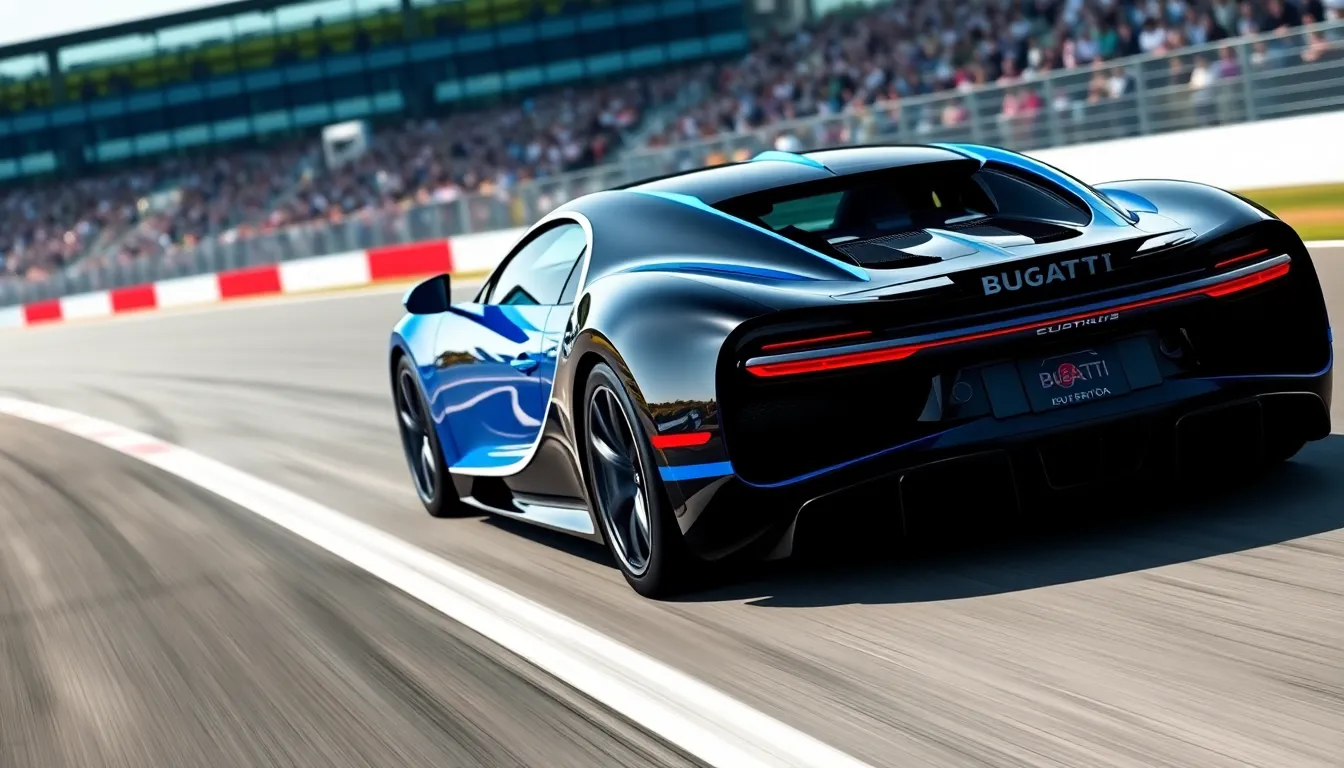We’ve all felt that rush of adrenaline when a supercar blasts past us on the highway leaving nothing but a blur and the echo of its roaring engine. Super fast cars represent the pinnacle of automotive engineering where cutting-edge technology meets raw power to create machines that defy the limits of speed and performance.
From the legendary Bugatti Chiron breaking 300 mph barriers to the electric Tesla Roadster promising mind-bending acceleration we’re witnessing an extraordinary era in automotive history. These mechanical marvels aren’t just about straight-line speed – they’re sophisticated pieces of art that combine aerodynamics materials science and computer precision to deliver experiences that push both man and machine to their absolute limits.
Whether you’re a speed enthusiast dreaming of track days or simply fascinated by what’s possible when engineering meets ambition we’ll explore the industry’s fastest production cars and the incredible technology that makes them possible.
Top Speed Demons: The Fastest Production Cars Ever Made
These automotive legends represent the pinnacle of engineering excellence, pushing the boundaries of what’s possible on four wheels. We’ve witnessed these manufacturers break barriers that once seemed impossible to achieve.
Bugatti Chiron Super Sport 300+
Bugatti’s masterpiece holds the official industry record for the fastest production car ever made. The Chiron Super Sport 300+ achieved an incredible 304.773 mph at Ehra-Lessien test track in Germany during August 2019.
We’re looking at a hypercar powered by an 8.0-liter quad-turbocharged W16 engine that produces 1,578 horsepower. The vehicle’s aerodynamic design features an extended rear section and modified bodywork specifically engineered for maximum velocity. Only 30 units were produced, making this speed demon one of the rarest supercars on Earth.
The car’s carbon fiber monocoque chassis provides exceptional rigidity while keeping weight to a minimum. Advanced active aerodynamics automatically adjust based on speed and driving conditions to maintain stability at extreme velocities.
SSC Tuatara
SSC North America’s Tuatara claimed multiple speed records with its twin-turbocharged 5.9-liter V8 engine generating up to 1,750 horsepower on racing fuel. The hypercar achieved a verified top speed of 282.9 mph during official testing runs in Nevada.
We’ve seen the Tuatara’s revolutionary design incorporate extensive wind tunnel testing and computational fluid dynamics. The vehicle’s drag coefficient of just 0.279 ranks among the lowest of any production car. Carbon fiber construction throughout the chassis and body panels keeps the total weight under 2,900 pounds.
Active aerodynamic elements include a deployable rear wing and front splitter that automatically adjust for optimal downforce or minimum drag. The car’s sophisticated traction control system uses multiple sensors to maintain grip during high-speed acceleration runs.
Koenigsegg Jesko Absolut
Koenigsegg’s Jesko Absolut represents the Swedish manufacturer’s ultimate pursuit of top speed performance. The hypercar features a theoretical top speed exceeding 330 mph based on aerodynamic modeling and powertrain capabilities.
We’re examining a vehicle equipped with a 5.0-liter twin-turbocharged V8 engine producing 1,600 horsepower on racing fuel. The Absolut variant removes all active aerodynamic elements from the standard Jesko to minimize drag. Koenigsegg’s proprietary Light Speed Transmission delivers lightning-fast gear changes in under 20 milliseconds.
The car’s carbon fiber body incorporates active underbody panels that create a venturi effect for enhanced aerodynamic efficiency. Advanced suspension geometry and lightweight construction result in exceptional power-to-weight ratios that enable extraordinary acceleration capabilities.
Revolutionary Hypercars That Redefined Speed Limits

These groundbreaking machines pushed automotive engineering into uncharted territory, establishing new benchmarks for what’s possible in high-performance manufacturing.
McLaren Speedtail
McLaren’s Speedtail represents the ultimate fusion of hybrid technology and aerodynamic perfection. This revolutionary hypercar achieves a top speed of 250 mph through its innovative petrol-electric powertrain that produces 1,035 horsepower. We’re looking at a vehicle that stretches 17.4 feet in length, making it the longest McLaren ever produced.
Aerodynamics define every curve and surface of the Speedtail’s carbon fiber body. McLaren engineers eliminated traditional door mirrors, replacing them with retractable digital cameras that reduce drag coefficient to just 0.278. The car’s teardrop silhouette channels airflow seamlessly from nose to tail, while active rear ailerons adjust automatically to maintain stability at extreme speeds.
Three seats arrange passengers in McLaren’s signature central driving position configuration. This layout places the driver at the vehicle’s centerline for optimal weight distribution and control. Carbon fiber construction keeps the total weight at 3,153 pounds even though the hybrid system’s additional components.
Rimac Nevera
Rimac’s Nevera demolished every acceleration record with its quad motor electric powertrain. This Croatian hypercar generates 1,914 horsepower and 1,740 pound-feet of torque, launching from 0-60 mph in just 1.85 seconds. We’ve witnessed this machine complete the quarter mile in 8.582 seconds, establishing it as the fastest production car ever tested.
Four independent electric motors provide unprecedented control over each wheel’s power delivery. Rimac’s advanced torque vectoring system adjusts power distribution 100 times per second, enabling precise handling characteristics that traditional mechanical systems can’t match. The 120 kWh battery pack supplies energy through a sophisticated thermal management system that maintains optimal temperatures during extreme performance runs.
Carbon fiber construction and advanced materials science create exceptional structural integrity. Rimac developed their own carbon fiber weaving techniques specifically for the Nevera’s monocoque chassis. The vehicle weighs 4,740 pounds while maintaining the rigidity necessary for 258 mph top speed capabilities.
Pagani Huayra BC
Pagani’s Huayra BC transforms track-focused engineering into road-legal artistry. This Italian masterpiece produces 789 horsepower from its AMG-sourced twin-turbocharged V12 engine while weighing just 2,685 pounds. We’re examining a vehicle that achieves a power-to-weight ratio of 653 horsepower per ton.
Active aerodynamics adjust continuously to optimize downforce and drag coefficients. Four independent flaps move across the car’s surface, responding to steering inputs, speed, and lateral acceleration forces. Pagani’s system generates up to 1,102 pounds of downforce at 174 mph while maintaining the aesthetic beauty that defines their brand philosophy.
Handcrafted carbon-titanium construction showcases traditional Italian artisanship. Every Huayra BC requires over 16 weeks to complete, with skilled craftsmen hand-laying each carbon fiber component. The interior features leather and carbon fiber elements that Pagani sources from specialized suppliers across Europe, creating an environment that balances racing functionality with luxury appointments.
Engineering Marvels: What Makes Super Fast Cars So Quick

The extraordinary speeds achieved by modern supercars aren’t just the result of raw power. They represent the perfect harmony of aerodynamic science, advanced materials engineering, and cutting-edge propulsion technology.
Aerodynamic Design and Wind Tunnel Testing
Aerodynamic efficiency forms the foundation of every super fast car’s ability to slice through air resistance. Engineers spend countless hours in wind tunnels, analyzing airflow patterns and pressure differentials around vehicle bodies to minimize drag coefficients.
Active aerodynamics systems automatically adjust spoilers, diffusers, and air intakes based on speed and driving conditions. The McLaren Speedtail’s retractable digital cameras replace traditional side mirrors, reducing drag by eliminating protruding elements that disrupt smooth airflow.
Underbody paneling creates ground effect downforce, literally sucking cars to the pavement for enhanced stability at extreme speeds. Venturi tunnels channel air beneath the chassis, generating negative pressure zones that increase traction without adding weight through traditional wing designs.
Front splitters and rear diffusers work together to manage airflow separation points, preventing turbulence that would otherwise create drag and instability. These components direct air around and under the vehicle in carefully calculated patterns that maximize both speed potential and cornering grip.
Lightweight Materials and Carbon Fiber Construction
Carbon fiber construction revolutionizes super fast car performance by delivering exceptional strength while maintaining minimal weight. This advanced composite material weighs 75% less than steel while providing superior rigidity and crash protection in critical structural areas.
Titanium components replace traditional steel hardware in engines, exhaust systems, and suspension mountings to shed additional pounds. Each titanium bolt or bracket contributes to overall weight reduction strategies that can save hundreds of pounds across entire vehicle builds.
Advanced honeycomb structures within carbon fiber panels create maximum strength-to-weight ratios through strategic material distribution. Engineers hollow out non-critical areas while reinforcing load-bearing sections, resulting in chassis that are both incredibly light and remarkably strong.
Aluminum space frames provide rigid foundations for carbon fiber body panels while maintaining optimal weight distribution. These precision-engineered structures position heavy components like engines and transmissions to achieve perfect balance for high-speed stability.
High-Performance Engine Technology
Forced induction systems multiply engine power output through turbochargers and superchargers that compress incoming air for more efficient combustion. The Bugatti Chiron’s quad-turbocharged W16 engine produces 1,479 horsepower by forcing massive amounts of air through its 16 cylinders.
Direct injection technology precisely controls fuel delivery timing and quantity for optimal power production at every RPM range. High-pressure fuel systems atomize gasoline into microscopic particles that burn more completely, extracting maximum energy from each combustion cycle.
Advanced engine management systems continuously monitor hundreds of sensor inputs to optimize ignition timing, fuel mapping, and boost pressure. These computer-controlled systems make thousands of adjustments per second to maintain peak performance under varying conditions.
Hybrid powertrains combine internal combustion engines with electric motors to fill torque gaps and provide instant acceleration response. The Rimac Nevera’s quad motor electric setup delivers 1,914 horsepower with zero lag time, eliminating the power delivery delays associated with traditional engines.
Electric Speed Machines: The Future of Super Fast Cars
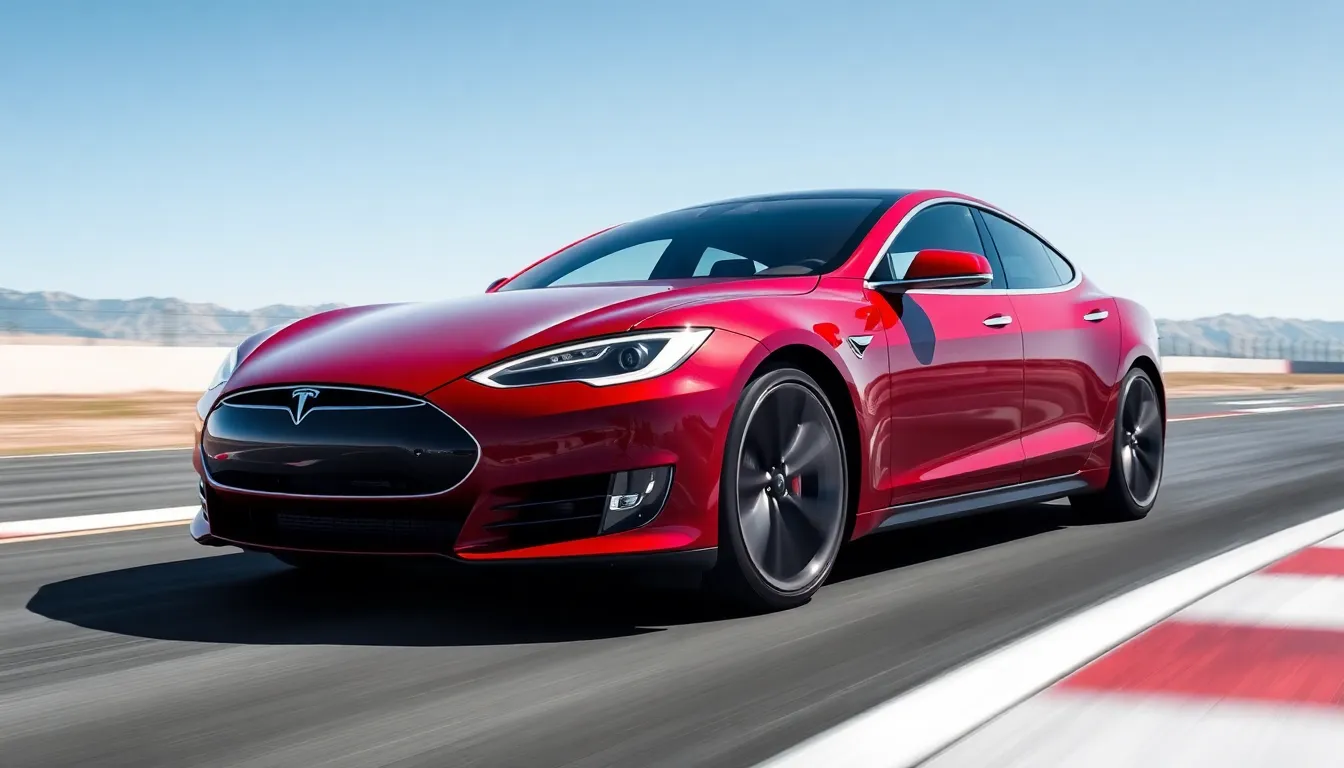
Electric powertrains are revolutionizing the supercar industry with instant torque delivery and groundbreaking acceleration capabilities. We’re witnessing a fundamental shift where electric motors challenge traditional combustion engines in pure performance metrics.
Tesla Model S Plaid
Tesla’s Model S Plaid transforms electric vehicle performance with its tri motor all wheel drive system producing 1,020 horsepower. We’ve seen this sedan achieve 0 to 60 mph in just 1.99 seconds, making it one of the quickest production cars ever built. The vehicle reaches a top speed of 200 mph while maintaining the practicality of a four door family sedan.
Performance Specifications:
| Metric | Tesla Model S Plaid |
|---|---|
| Horsepower | 1,020 hp |
| 0-60 mph | 1.99 seconds |
| Top Speed | 200 mph |
| Range | 396 miles |
| Price | $108,490 |
Advanced battery technology enables the Plaid’s remarkable performance through precise thermal management and optimized energy delivery. Carbon fiber components reduce weight while maintaining structural integrity for high speed stability. Track mode provides customizable settings that adjust powertrain behavior for maximum performance on closed circuits.
Lucid Air Sapphire
Lucid’s Air Sapphire establishes new benchmarks for electric luxury performance with its 1,234 horsepower tri motor configuration. We observe this flagship sedan accelerating from 0 to 60 mph in an astounding 1.89 seconds while offering over 400 miles of EPA estimated range. The vehicle combines track ready performance with premium interior craftsmanship and advanced autonomous driving capabilities.
Performance Specifications:
| Metric | Lucid Air Sapphire |
|---|---|
| Horsepower | 1,234 hp |
| 0-60 mph | 1.89 seconds |
| Top Speed | 205 mph |
| Range | 427 miles |
| Price | $249,000 |
Sophisticated aerodynamic design optimizes both efficiency and high speed stability through active air suspension and retractable door handles. Glass canopy roof construction maximizes interior space while maintaining structural rigidity for performance driving. Advanced cooling systems ensure consistent power delivery during extended high performance sessions.
Pininfarina Battista
Pininfarina’s Battista represents the pinnacle of electric hypercar engineering with 1,900 horsepower from four electric motors. We recognize this Italian masterpiece as producing more power than a Formula 1 car while achieving 0 to 60 mph in under 2 seconds. Limited production of just 150 units makes the Battista one of the most exclusive electric vehicles ever created.
Performance Specifications:
| Metric | Pininfarina Battista |
|---|---|
| Horsepower | 1,900 hp |
| 0-60 mph | 1.86 seconds |
| Top Speed | 217 mph |
| Range | 280 miles |
| Price | $2,200,000 |
Carbon fiber monocoque construction provides exceptional rigidity while keeping weight to just 4,850 pounds even though the massive battery pack. Active aerodynamics adjust automatically to optimize downforce or reduce drag based on driving conditions and selected performance modes. Brembo carbon ceramic brakes deliver stopping power equivalent to the vehicle’s acceleration capabilities for complete performance balance.
Legendary Speed Icons That Changed Automotive History
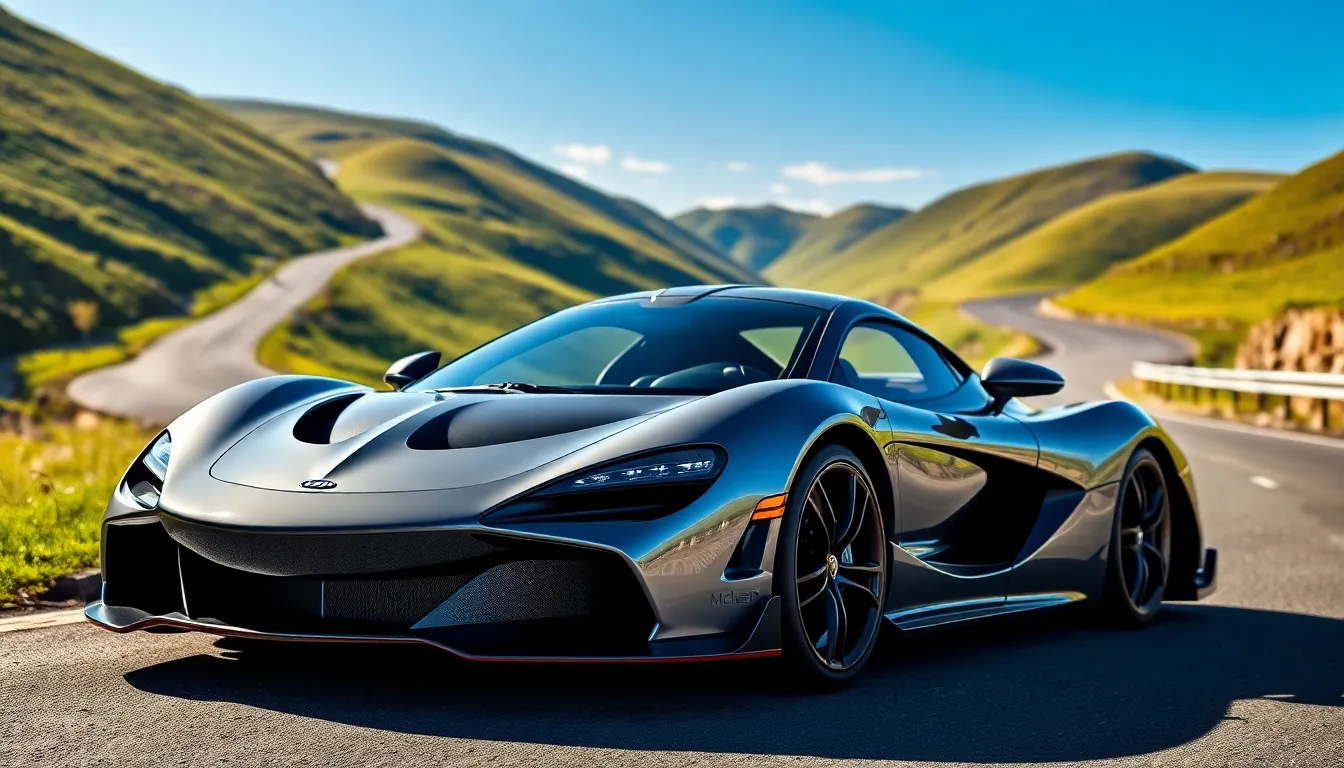
Throughout automotive history, certain supercars have transcended their role as mere transportation to become cultural phenomena that redefined what we thought possible on four wheels.
McLaren F1
McLaren F1 remains the ultimate expression of analog supercar engineering, setting benchmarks that manufacturers still chase today. Gordon Murray’s masterpiece achieved 240.1 mph in 1998, making it the fastest production car for over a decade with its naturally aspirated BMW V12 engine producing 627 horsepower.
Central driving position creates an unparalleled connection between driver and machine, flanked by two passenger seats in a unique three-seat configuration. We witnessed revolutionary materials engineering with its carbon fiber monocoque chassis, weighing just 2,509 pounds while maintaining exceptional rigidity and crash protection.
Gold-lined engine bay reflects heat away from the naturally aspirated 6.1-liter V12, demonstrating McLaren’s obsessive attention to thermal management. Performance figures include 0-60 mph acceleration in 3.2 seconds and a quarter-mile time of 11.1 seconds, achievements that impressed enthusiasts for decades.
Bugatti Veyron
Bugatti Veyron revolutionized the hypercar segment when it debuted in 2005, proving that extreme luxury and record-breaking speed could coexist in a single package. Ferdinand Piëch’s vision materialized into a 1,001-horsepower masterpiece powered by an 8.0-liter quad-turbocharged W16 engine that redefined automotive engineering possibilities.
Top speed of 253.81 mph required innovative answers like active aerodynamics, dual-clutch transmission, and all-wheel drive to manage the immense power safely. We observed groundbreaking cooling systems with 10 radiators working together to prevent overheating during high-speed runs and daily driving conditions.
Engineering complexity includes 16 cylinders, 64 valves, and four turbochargers working in harmony to deliver seamless power across the entire RPM range. Price tag of $1.7 million reflected the extensive development costs and hand-built construction methods that Bugatti employed in their Molsheim factory.
Ferrari LaFerrari
Ferrari LaFerrari introduced hybrid technology to the hypercar industry in 2013, combining a naturally aspirated V12 with electric assistance to create 950 total horsepower. Maranello’s flagship demonstrated that electrification could enhance rather than compromise the emotional connection between driver and supercar.
KERS-derived hybrid system adds 161 horsepower from its electric motor, working seamlessly with the 789-horsepower 6.3-liter V12 engine to deliver instantaneous throttle response. We experienced active aerodynamics that automatically adjust based on speed and driving conditions, optimizing downforce and drag coefficient without driver intervention.
Track-focused engineering achieves 0-60 mph acceleration in under 3 seconds and a top speed exceeding 217 mph, while maintaining the distinctive Ferrari V12 soundtrack that enthusiasts cherish. Limited production of 499 units plus additional special variants created exclusivity that placed LaFerrari among the most coveted modern Ferraris in collector circles.
Track-Focused Beasts: Super Fast Cars Built for Racing
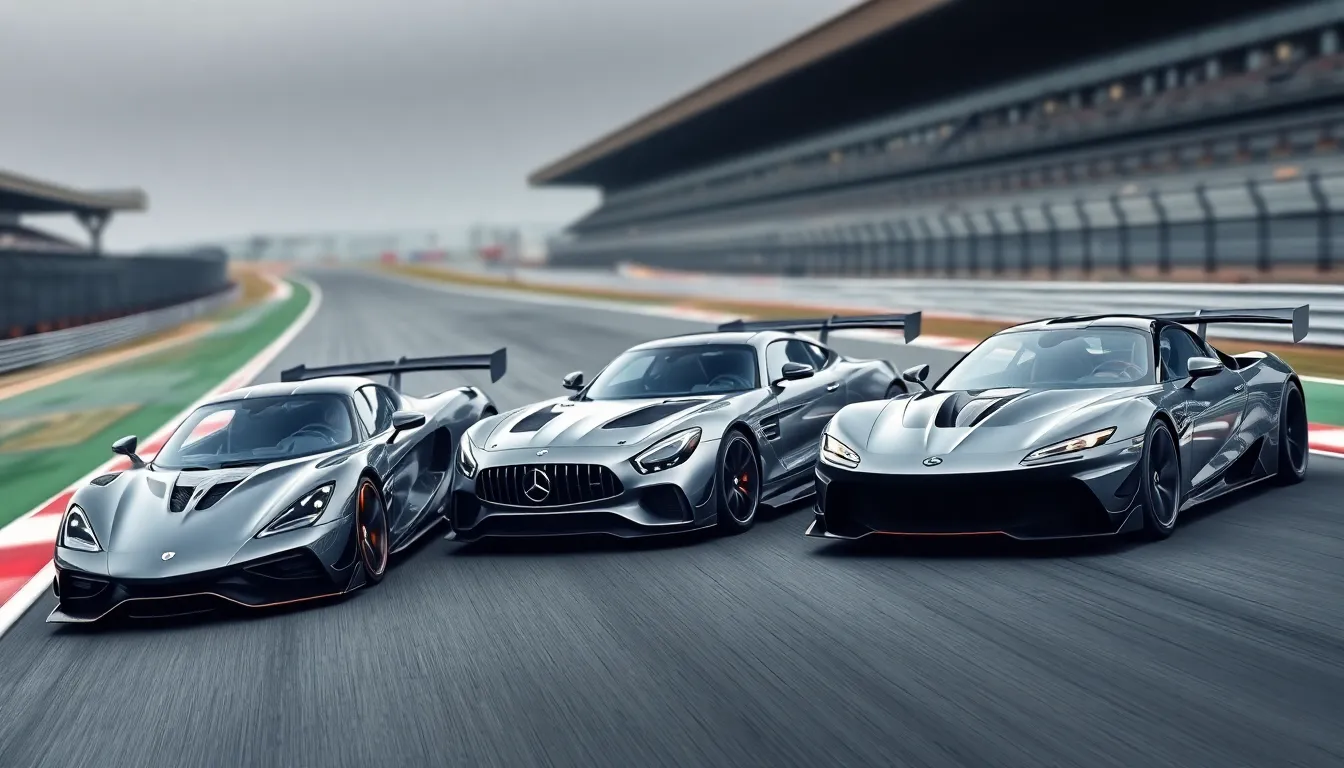
Track-focused supercars represent the ultimate fusion of Formula 1 technology and road car engineering. We’ve identified three exceptional machines that blur the line between race car and street legal vehicle.
Koenigsegg One:1
Koenigsegg One:1 delivers an unprecedented 1,340 horsepower from its twin-turbocharged 5.0-liter V8 engine, creating a perfect 1:1 power-to-weight ratio. This Swedish hypercar weighs exactly 1,340 kilograms, making it the first production car to achieve this engineering milestone. Active aerodynamics generate over 1,345 pounds of downforce at 160 mph, transforming the One:1 into a ground-hugging missile on track surfaces.
Track-exact features include a massive rear wing that adjusts automatically based on speed and cornering forces. Carbon fiber construction extends throughout the entire chassis and body panels, reducing weight while maintaining structural integrity. Only six examples exist worldwide, making the One:1 one of the rarest track-focused supercars ever produced.
Mercedes-AMG Project One
Mercedes-AMG Project One transfers Formula 1 technology directly from Lewis Hamilton’s championship-winning race car to the street. Its hybrid powertrain combines a 1.6-liter turbocharged V6 engine with four electric motors, producing a combined 1,063 horsepower. The engine redlines at an astounding 11,000 RPM, matching the specifications of Mercedes’ F1 power unit.
Active aerodynamics include a deployable rear wing and front splitter that adjust in real-time for maximum downforce or minimum drag. Carbon fiber monocoque construction borrows directly from F1 chassis design, providing exceptional rigidity while keeping weight to 3,737 pounds. Production remains limited to 275 units, with each vehicle requiring hand assembly at Mercedes’ specialized facility.
Aston Martin Valkyrie
Aston Martin Valkyrie represents the collaboration between Aston Martin and Red Bull Racing’s Formula 1 team. Its naturally aspirated 6.5-liter V12 engine produces 1,000 horsepower, supplemented by a 160-horsepower electric motor for a total output of 1,160 horsepower. Weight distribution achieves perfect 50:50 balance through strategic component placement and carbon fiber construction.
Aerodynamic efficiency reaches Formula 1 levels through ground effect technology and active suspension systems. The Valkyrie generates its own weight in downforce at 150 mph without relying on traditional wings or spoilers. Interior design prioritizes driver focus with a reclined seating position and minimal dashboard layout inspired by single-seat race cars. Production numbers total 150 road cars and 25 track-only variants.
Price Tags of Velocity: The Most Expensive Super Fast Cars
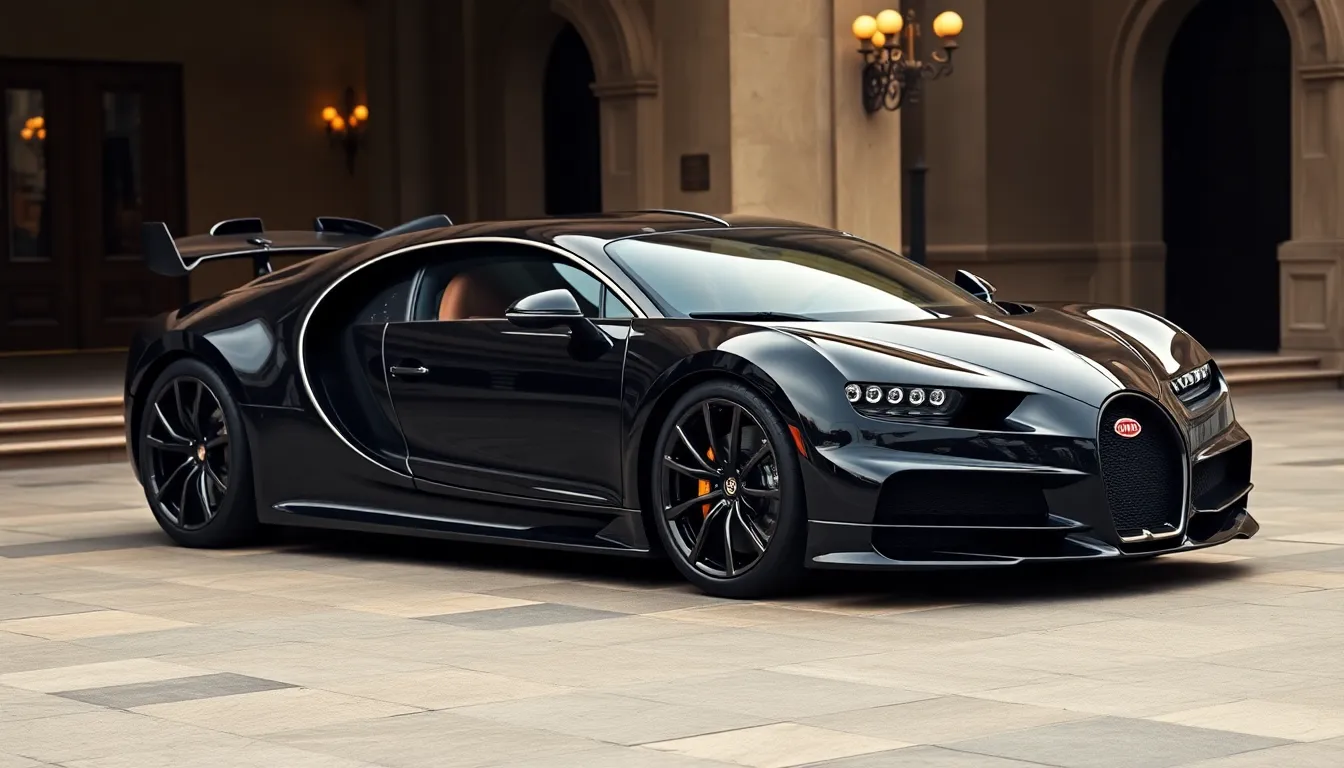
Performance engineering reaches its financial peak when automakers create masterpieces that command astronomical prices. We’re diving into the exclusive area where speed meets luxury in the most expensive ways imaginable.
Limited Edition Models
Bugatti La Voiture Noire stands as the pinnacle of automotive luxury with its $18.7 million price tag. This one-off hypercar pays homage to the legendary Type 57 SC Atlantic while delivering 1,479 horsepower from its quad-turbocharged W16 engine. Production numbers remain exclusive at just one unit, making it the ultimate collector’s dream.
McLaren Speedtail Hermès Edition commands $4.3 million through its collaboration with the legendary fashion house. Limited to only 106 units globally, this hypercar features bespoke Hermès leather interiors and custom paint schemes. Speed capabilities reach 250 mph while maintaining the artistic craftsmanship that justifies its premium pricing.
Koenigsegg CCXR Trevita achieves its $4.8 million valuation through revolutionary diamond weave carbon fiber bodywork. Manufacturing constraints limited production to just two examples worldwide, creating unprecedented rarity. Power output reaches 1,018 horsepower from its supercharged V8 engine, combining extreme performance with visual brilliance.
Pagani Zonda HP Barchetta represents the ultimate farewell to the Zonda lineage at $17.5 million per unit. Production totaled only three examples, each featuring a naturally aspirated V12 AMG engine producing 789 horsepower. Design elements include a distinctive windshield-less configuration that emphasizes pure driving connection.
Auction Records and Collector Values
Ferrari 250 GTO shattered records when chassis 4153GT sold for $70 million in 2018. This racing legend represents the holy grail of automotive collecting with only 36 examples ever produced between 1962 and 1964. Market appreciation has been extraordinary, with values increasing over 5,000% since the 1980s.
McLaren F1 continues breaking auction barriers, with recent sales exceeding $20 million for pristine examples. Production totaled just 106 road cars between 1992 and 1998, creating natural scarcity that drives collector demand. Performance credentials include a top speed of 240.1 mph that remained unmatched for over a decade.
Bugatti Type 57SC Atlantic achieved $40 million when the Rothschild family’s example changed hands privately. Only four examples were ever constructed, with two remaining in existence today. Aerodynamic brilliance from the 1930s combined with Art Deco styling creates timeless appeal that transcends automotive collecting.
Porsche 917K from Steve McQueen’s “Le Mans” movie sold for $14 million in 2017. Racing provenance and Hollywood connection elevated this particular chassis above standard 917 values. Competition history includes multiple victories at prestigious endurance races throughout the early 1970s.
Cost Per Horsepower Analysis
| Vehicle | Price | Horsepower | Cost Per HP |
|---|---|---|---|
| Bugatti La Voiture Noire | $18.7M | 1,479 | $12,643 |
| McLaren Speedtail Hermès | $4.3M | 1,035 | $4,155 |
| Koenigsegg CCXR Trevita | $4.8M | 1,018 | $4,715 |
| Pagani Zonda HP Barchetta | $17.5M | 789 | $22,181 |
| Ferrari LaFerrari Aperta | $2.2M | 950 | $2,316 |
Pagani Zonda HP Barchetta delivers the highest cost per horsepower at $22,181, reflecting its extreme rarity and artistic value over pure performance metrics. Engineering excellence combines with sculptural beauty to justify premium pricing that transcends traditional performance calculations.
Ferrari LaFerrari Aperta offers the most accessible cost per horsepower among hypercars at $2,316 per unit. Hybrid technology integration provides 950 total horsepower while maintaining the prestigious Ferrari heritage that collectors demand. Production totaled 210 examples, creating sufficient rarity without extreme exclusivity.
Koenigsegg CCXR Trevita achieves a middle ground at $4,715 per horsepower through its revolutionary carbon fiber construction. Swedish engineering prowess delivers exceptional performance while the diamond weave bodywork creates visual drama worth the premium. Manufacturing complexity justifies the elevated pricing structure compared to standard production models.
Conclusion
The industry of super fast cars represents humanity’s relentless pursuit of automotive perfection. We’ve witnessed how these magnificent machines continue pushing boundaries through groundbreaking engineering and innovative design philosophies that redefine what’s possible on four wheels.
From traditional combustion engines to revolutionary electric powertrains these speed demons showcase the incredible diversity of approaches to achieving ultimate performance. Each breakthrough paves the way for future innovations that’ll shape tomorrow’s automotive industry.
Whether you’re drawn to the raw power of a Bugatti Chiron or the instant torque of an electric hypercar one thing remains clear: our fascination with speed continues driving the industry toward even greater achievements. These automotive masterpieces aren’t just vehicles – they’re rolling testaments to human ingenuity and our endless search for perfection.
Frequently Asked Questions
What is the fastest production car in the world?
The Bugatti Chiron Super Sport 300+ holds the record as the fastest production car, reaching a verified top speed of 304.773 mph. This hypercar is powered by a quad-turbocharged W16 engine that produces incredible power, making it the ultimate speed demon in automotive history.
How fast can electric supercars accelerate?
Electric supercars offer revolutionary acceleration thanks to instant torque delivery. The Rimac Nevera holds the record at 0-60 mph in just 1.85 seconds, while the Tesla Model S Plaid achieves 0-60 mph in 1.99 seconds. Electric powertrains provide immediate power without the lag of traditional engines.
What makes supercars so expensive?
Supercar prices reflect advanced engineering, rare materials, limited production, and exclusive craftsmanship. The most expensive models like the Bugatti La Voiture Noire ($18.7 million) combine cutting-edge technology, carbon fiber construction, hand-built components, and extreme rarity that appeals to collectors worldwide.
What engineering technologies enable supercar speed?
Supercars achieve extreme speeds through aerodynamic design, lightweight carbon fiber construction, advanced engine technology, and active aerodynamics systems. Wind tunnel testing optimizes airflow, while forced induction and hybrid powertrains maximize power output for unprecedented performance capabilities.
How do track-focused supercars differ from regular supercars?
Track-focused supercars like the Koenigsegg One:1 and Mercedes-AMG Project One incorporate Formula 1 technology, active aerodynamics, and extreme power-to-weight ratios. These vehicles prioritize downforce, cornering performance, and lap times over pure comfort, blurring the line between race cars and street-legal vehicles.
What role do materials play in supercar performance?
Advanced materials, particularly carbon fiber, are crucial for supercar performance. Carbon fiber offers exceptional strength-to-weight ratios, reducing overall vehicle weight while maintaining structural integrity. This weight reduction directly improves acceleration, handling, braking, and top speed while enabling more aggressive aerodynamic designs.
Are hybrid supercars as fast as traditional ones?
Hybrid supercars often outperform traditional models by combining electric motors with combustion engines. The Ferrari LaFerrari produces 950 total horsepower through hybrid assistance, while the McLaren Speedtail reaches 250 mph. Hybrid technology provides instant torque and improved power delivery.
What makes some supercars worth millions at auction?
Auction values depend on rarity, historical significance, racing provenance, and condition. The Ferrari 250 GTO sold for $70 million due to its legendary racing history and extreme scarcity. Limited production numbers, celebrity ownership, and motorsport achievements significantly increase collector value over time.

